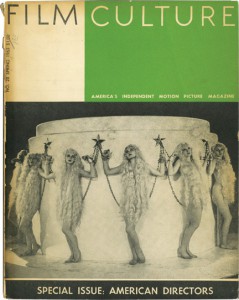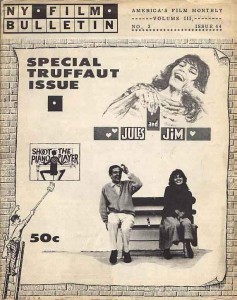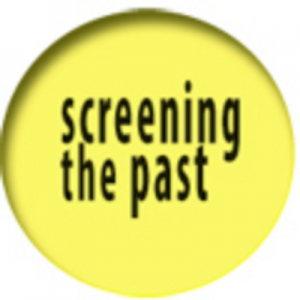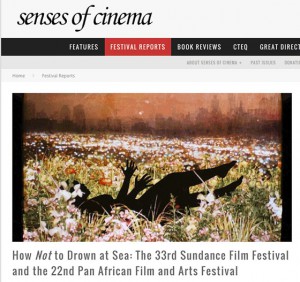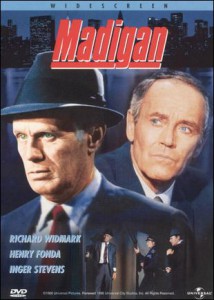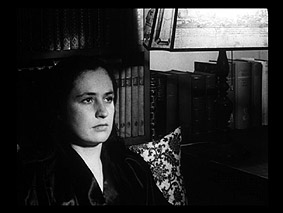From Film Quarterly, March 2007, vol. 60, no. 3; reprinted in Goodbye Cinema, Hello Cinephilia. Obviously some of this is out of date by now. — J.R.
There’s a part of me that understands perfectly why a
minimalist like Jim Jarmusch and a 19th century figure like
Raul Ruiz won’t have anything to do with email. “You can’t
smell email,” Ruiz once said to me, to explain part of the
reason for his distaste. But I find it tougher to feel
nostalgic about film criticism before the Internet, because
even though you could smell it, the choices of what you
could lay your hands on outside a few well-stocked
university libraries were fairly limited. Similarly, the
choices of what films you could see outside a few cities
like New York and Paris before DVDs was pretty narrow, and
possibly even more haphazard than what you could read about
them.
These two developments shouldn’t be considered in
isolation from one another. The growth of film writing on
the web —- by which I mean stand-alone sites, print-magazine
sites, chatgroups, and blogs —- has proceeded in tandem with
other communal links involving film culture that to my mind
are far more important than the decline in the theatrical
distribution of art films and independent films, so I’ll be
periodically discussing those links here.
When I started out as a cinephile in New York in the
early 60s, the English-language magazines that counted the
most were the ones that went furthest in gathering together
diverse constituencies: Sight and Sound, Film Culture, and
Film Quarterly. Even the more local and partisan New York
Film Bulletin was translating texts from Cahiers du Cinéma.
Of course the film world was much smaller then, and some of
the nostalgia for that era undoubtedly focuses on the
coziness. By the time film writing on the web started, film
culture had spread and splintered into academia and
journalism, which often lamentably functioned as mutually
indifferent or sometimes even mutually hostile
institutions. So the theoretical golden age, I assume, took
place before all the institutionalizing.
Significantly, the most enterprising early efforts to
disseminate film writing on the web were neither American
nor English but Australian —- most notably the academic and
peer-reviewed Screening the Past, founded by classical and
fine arts scholar Ina Bernard in Melbourne in 1997, and the
more journalistic Senses of Cinema, founded by filmmaker
Bill Mousoulis in the same city in 1999. Both publications
are still going strong — having published 19 and 40 issues
respectively by late 2006, and continuing to keep all their
previous issues online, although Senses underwent several
changes after the departure circa 2002 of Mousoulis and
another editor, critic Adrian Martin, the latter of whom
went on to cofound the no less ambitious Rouge in 2003.
It’s easy to hypothesize that this Australian concentration
came from both a highly developed and interactive local
film community and a desire both to be recognized by and to
communicate with the wider world of cinephilia.
Three other extremely useful film sites that have by
now become regarded as staples include the English and
academic www.film-philosophy.com, the American and
basically journalistic http://daily.greencine.com/, and the
international www.mastersofcinema.com (which functions
mainly though not exclusively as a guide to what’s coming
out on DVD) — all especially valuable, as is Senses, as
conduits to other sites. Then there are the sites
maintained by film magazines (e.g., Sight and Sound, Film
Comment, Cineaste, Cinema Scope), which offer samples
rather than exhaustive duplications of their latest issues,
and those sites that have replaced former magazines on
paper, such as Bright Lights.
My acquaintance with blogs and chatgroups has been
more limited, but a few of each might be mentioned here.
Among the more notable critics’ blogs are ones devoted to
Serge Daney in English (http://sergedaney.blogspot.com) and
to Raymond Durgnat (currently in hiatus, though expected to
return [2016: it’s now back]), ones maintained by Fred Camper, Steve Erickson, Chris Fujiwara, and Dave Kehr, and Saul Symonds’ www.lightsleepcinemamag.com, which also originated in Australia, and prints or reprints a few texts by other critics not readily available elsewhere. And the main
chatgroups I’m familiar with are the auteurist “a film by,”
“film and politics” (which started out as a splinter group
deriving from the former, and is also on Yahoo), and a few
separate chatgroups located on the elaborate site
www.wellesnet.com (“the Orson Welles web resource”). The
latter calls to mind a slew of other director-based sites,
including especially impressive ones devoted to Robert
Bresson, Carl Dreyer, Jonas Mekas, and Jacques Tati.
***
How wide are the readerships of such resources? Klaus
Eder, who for many years has been the general secretary of
FIPRESCI, the international film critics organization,
recently told me that Undercurrent — an online, Englishlanguage
magazine established on their website in 2006, edited by Chris Fujiwara, that has so far published only three issues —- had about 100,000 readers per month. Considering how specialized the magazine’s turf is — encompassing such topics as the late film critic Barthélemy Amengual, Alexander Dovzhenko, the acting in Don Siegel’s Madigan, Austrian cinema, sound designer Leslie Schatz,
assorted short films, and recent features about Cameron
Crowe, Philippe Garrel, Danièle Huillet, Terrence Malick,
Park Chan-wook, and Tsai Ming-liang — and considering that
100,000 readers seems to comprise more than those of all
film magazines on paper combined, this was a startling
piece of information, and one that initially beggared
belief. It was also hard to square this figure with one
given to me by Gary Tooze regarding a recent piece of mine
called “Ten Overlooked Fantasy Films on DVD (and Two That
Should Be!)” on his much more commercial and consumer oriented web site, DVD Beaver. (In that case, he estimated
about 10,000 hits during the first week the article was
posted.) But once Klaus added that the average length of time
spent by each reader of Undercurrent was roughly two
minutes, I started to realize that my shock was premature,
and that my superimposition of two incompatible grids —- one
devoted to subscribers and readers of paper magazines such
as Cahiers du Cinéma, Film Quarterly, and Sight and Sound,
the other devoted to web surfers —- could only lead to
muddled conclusions. And I’m not sure that the comparison
with DVD Beaver is very meaningful without the average
length of time of each hit in that case, which I don’t know.
I also recently learned from David Bordwell that his
web site at www.davidbordwell.net “receives between 250-450
unique visitors each day, with an average of 2-3 pageloads per visitor.
Most visitors on any day are first-time visitors, with about 60-100
coming back from a previous day. Heaviest usage is from the US and
Europe, which you’d expect.” I don’t think we can meaningfully
compare these figures with the sales of Bordwell’s books
(which I didn’t ask him about), and I’m not even sure how
meaningfully we can compare Bordwell’s site with
Undercurrent, given the range of things that web-surfers
are looking for. Bordwell largely uses his site to update
and expand many of his writings on paper, and this already
points to functions that are qualitatively different from
those of published works.(1)
Extrapolating from all this, I started to realize that
current claims that film criticism is becoming extinct, and
counter-claims that it’s entering a new golden age, are
equally misguided if they assume that film criticism as an
institution functions the same way on paper and in
cyberspace, as two versions of the same thing rather than
as separate enterprises. Related debates about the
distribution of foreign films in the English-speaking world
(drastically shrinking in theaters, drastically expanding
in the production and distribution of DVDs), or the
sophistication of young filmgoers regarding film history
(growing if you follow some chatgroups, declining if you
follow certain others), or the number of films that get
made (even more difficult to determine if videos and films
are treated interchangeably) seem equally incoherent due to
the disparity of reference points, creating a Tower of
Babel in a good many discussions. It’s a central aspect of
our alienated relation to language that when someone says,
“I just saw a film,” we don’t know whether this person saw
something on a large screen with hundreds of other people
or alone on a laptop —- or whether what he or she saw was on
film, video, or DVD, regardless of where and how it was
seen.
In short, we’re living in a transitional period where
enormous paradigmatic shifts should be engendering new
concepts, new terms, and new kinds of analysis, evaluation,
and measurement, not to mention new kinds of political and
social formations, as well as new forms of etiquette. But
in most cases they aren’t doing any of those things. We’re
stuck with vocabularies and patterns of thinking that are
still tied to the ways we were watching movies half a
century ago.
If we consider briefly just the question of email and
chatgroup etiquette, we already encounter a daunting array
of new kinds of behavior. If sending an email to someone
can sometimes partake of the kind of intimacy associated
with whispering, there are also arguably new forms of
interpersonal brutality that crop up periodically in
chatgroups, obliging some leaders of such groups to impose
certain standards of civility between members. Even
definitions of what constitutes a stranger or evaluations
of the importance of typos has undergone a certain amount
of transformation within the new context of chatgroups, and
there are few of us who aren’t still finding our bearings
within such contexts.
***
In order to grasp some of the new tricks that some of
the old dogs are failing to learn, it helps if we start
redefining what we mean by community in relation to
geography, which is central to all these paradigmatic
shifts. It becomes relevant, for example, that Fujiwara
edits Undercurrent from Tokyo as well as from Boston, and
that the editor of Film Quarterly, published by the
University of California Press, works out of London —- and
perhaps even that this sentence is initially being written
on a plane between Chicago and Vancouver —- especially if we
persist in regarding the discourse of both magazines as a
discourse being aimed at a specific geographically-based
constituency seen in relation to a particular nation-state,
town or city, university or other institution. Speaking as
someone who currently feels that he lives on the Internet
more than he lives in Chicago, I consider this distinction
vital to the ways that I function as a writer. Maybe it’s
also relevant that Rouge, the most ambitious of the
international online film magazines (translating some of
its texts into English from Chinese, French, German,
Italian, Japanese, Portuguese, and Spanish sources),
originates from Australia —- or at least from three
Australian editors, who may at any given time be in France,
Greece, or elsewhere while doing part of their editorial
work. But if it is relevant, this is largely because
Australia is itself multicultural, also yielding a
multicultural, state-run TV channel, SBS, that similarly
has few counterparts.
It’s my own conviction that the nation-state itself is
fast becoming an outdated and dysfunctional concept, apart
from the special interests of politicians and corporations
and their own highly functional designation of countries as
markets. It seems bewildering that while most of the world
appears to detest George W. Bush as much as I do, this fact
has been deemed totally irrelevant to political strategy
and activity within the Democratic Party, so that the U.S.
currently appears to be more isolated from the rest of the
world than it was during the cold war — in spite of the
unprecedented possibilities of communication and
interactivity made possible by the Internet. And if we
scale down this striking paradox to the more modest
dimensions of film culture, the same anomalies are
apparent. The choices of ordinary filmgoers are said to be
steadily shrinking at the same time that most of the riches
of world cinema are becoming internationally available for
the first time on DVD.
Part of our problem in assessing our new conditions is
a bad habit of often assuming by reflex that they’re either
bad or good —- which is about as futile as arriving at such a
simplistic conclusion about globalization. Let me try to
illustrate this with a couple of extended personal
anecdotes. Shortly after September 11, 2001 attacks, I was
invited by the Chicago Reader’s editor to write something
reflecting on its aftermath. After she decided not to run
my article, I received a similar invitation from Senses of
Cinema, and emailed them the same piece, somewhat rewritten.
I wrote about my fear of what I described as American
as well as Middle Eastern terrorists —- by which I meant
Americans who suddenly started thinking about the vanished
World Trade Center as if it were their own private property
and the attacks of September 11 as if they were simply and
unambiguously an “attack on America,” thereby allowing the
Middle Eastern terrorists and their assumed positions to
set all the terms of the discussion and automatically
dismissing the non-Americans from over 80 countries who
were destroyed in the attacks as irrelevant. I was
especially upset by a poster with an American flag over the
words “September 11, 2001/We Will Not Forget,” placed on
the front door of the building where I live in Chicago by
an upstairs neighbor, who didn’t bother to consult anyone
else in the nine-unit building about it. Feeling that flags
were already being used to intimidate, to stop
conversations rather than start them, I objected at our
next condo meeting that “we will not forget” in this
context meant that we will forget all the non-Americans
killed —- at which point my neighbor left the room and
refused to discuss the matter further, with the result that
his poster remained up for many weeks afterwards. I
concluded that I was tempted to attribute part of this
terrible climate to a certain “narcissism about mourning”
that a visiting German filmmaker had recently mentioned to
me about some of her New York friends and acquaintances.
Less than an hour after the issue of Senses of Cinema
containing my article appeared online, I received an
abusive email from a New York film critic whom I knew only
slightly and who wrote me, in a fit of rage, that I had no
moral right to accuse people like him of being narcissistic
about mourning when he could still smell the ashes of burnt
flesh from his apartment. So three extremely disparate and
irreconcilable definitions of community were affecting me
all at once: a feeling of repression, censorship, and
bullying in the building where I live; an ability to
express this feeling freely and openly to like-minded
individuals on a web site located on the other side of the
planet; and an almost traumatic sensation of being
assaulted by an acquaintance 800 miles away for expressing
the same feeling. The first and last of these experiences
were nightmarish and dystopian, the second was utopian, and
the second two were possible only because of the Internet —
because I can’t imagine that the New York acquaintance
would ever have phoned me with the same message. And only
the first was geographically matched with where I happened
to be.
My second anecdote relates to the recent death of
Danièle Huillet, the filmmaking partner of Jean-Marie
Straub, and how this was both discovered and dealt with by
many people via “a film by”. Shortly after I learned about
this shocking and upsetting occurrence, when a friend in
New York, critic Kent Jones, phoned me, I posted what
little information I had in this chatgroup, and for roughly
the first 24 hours there was little if any response. But
when responses then started to come, they were detailed and
far-ranging, and came from such diverse quarters as Los
Angeles, Paris, the American Midwest, and Melbourne. They
included photographs of Huillet as a little girl growing up
on a farm (posted at http://kinoslang.blogspot.com, and furnished by Bernard Eisenschitz), which I had never even known existed, information about the first digital video of Straub-Huillet (which later proved to be obtainable online), links to an article in Libération and many older English- language texts —- and a detailed (and somewhat contentious) discussion about an obituary written by Dave Kehr for the New York Times, an obituary that conceivably might not have been written if the news about Huillet’s death hadn’t been posted in “a film by”.
More generally, the kind of discourse and behavior one
encounters in “a film by” seems to run the gamut from news
and critical analysis to childish and protracted exchanges
of insults — a mix that is by no means restricted to
chatgroups dealing with film, and which also can be
characterized as split between occasional and habitual (or
even compulsive) contributors — those who periodically visit
and those who appear to do very little apart from exchange
comments. Significantly, this particular group was
initially formed by critics Fred Camper and Peter Tonguette
to counter the impolite behavior in other film chatgroups,
and it continues to be monitored for that reason, but this
hasn’t prevented the discussions from periodically
descending into invective that overwhelms other forms of
communication. It would be interesting to hear from
psychologists and/or psychoanalysts about the psychic
reservoirs and “family plots” that appear to be tapped into
by these exchanges, leading to forms of behavior that seem
to be specific to the Internet and periodically undermine
some of the more progressive and utopian possibilities.
Thanks to the site of www.cinema-scope.com, where I
write a regular column called “Global Discoveries on DVD”
that usually appears online, I received one of the most
exciting glimpses of the utopian possibilities inherent in
film writing on the web. For some time, I have been
fantasizing that ciné-clubs, a major spur to French
cinephilia over most of the past century, could be making a
comeback, this time in global terms, thanks to DVDs. These
ciné-clubs could be situated almost anywhere, in houses and
configuration might be touring “retrospectives” on DVD in
which the DVDs could be sold at the screenings (perhaps
along with relevant books and/or pamphlets), in much the
same way that CDs are now often sold by music groups in
clubs between their sets. And if enough circuits for these
retrospectives could become established in this fashion,
this could ultimately finance the production of these
packages. In some ways this dream has already been realized
in the U.S. by www.moveon.org and the way it has arranged
private showings of such Robert Greenwald documentaries as
Uncovered, Out-Foxed, Wal-Mart, and Iraq for Sale, but it
doesn’t appear to have caught on with other kinds of films.
While attending the Mar del Plata film festival last spring, I met a schoolteacher based in Cordoba who had
established a few ciné-clubs in separate small towns that
he visited on a regular basis, and the films he showed
included some of the more specialized and esoteric films I
had written about, including Forough Farrokzhad’s The House
is Black (1962) and Kira Muratova’s Chekhov’s Motifs (2002).
He told me the combined audiences of such screenings for
each film was somewhere between 700 and 800 people.
Considering how unlikely it would be to fill single
auditoriums of that size in most major cities of the world
for such films, I realized that the shifting paradigms of
today might also transform what we normally regard as a
minority taste. Once the paradigm of a single geographical
base changes, all sorts of things can be transformed. Maybe
Muratova’s craziest feature is too difficult for most New
Yorkers and Parisians, but once it can be acquired globally
on DVD with the right subtitles, anything becomes possible
—- including a sizable group of viewers in Cordoba.
1. I was chagrined to discover that an essay of mine on
Eyes Wide Shut reprinted in American Movie Critics by
the Library of America, a publisher celebrated for
its “definitive” editions, introduced a typo in the
opening paragraph that reversed the meaning of the
sentence, changing “argue” to “agree” —- a typo that
hadn’t occurred in any of the article’s three other
appearances on paper. Ironically, if such a typo had
occurred in the Chicago Reader, where the article
first appeared, it could have been corrected a day
later in the Reader’s online edition, whereas the
Library of America’s typo, barring a second edition,
is permanent. [2009 Postscript: although a correction
sent to the Library of America went unacknowledged,
the subsequent paperback did correct the error.]
But this doesn’t necessarily make the Reader’s
online system superior in all respects. For the past
several years, due to space restrictions regarding
the Reader’s paper edition, all its capsule film
reviews that run past a particular length now have to
be permanently shortened for both the paper and its
online editions. Thus the older issues on paper
preserve longer capsules that are no longer available
anywhere else, while the capsules available online
can theoretically be altered on a week to week basis
and thus have none of the same archival status and
value.
— Film Quarterly, March 2007, vol. 60, no. 3

